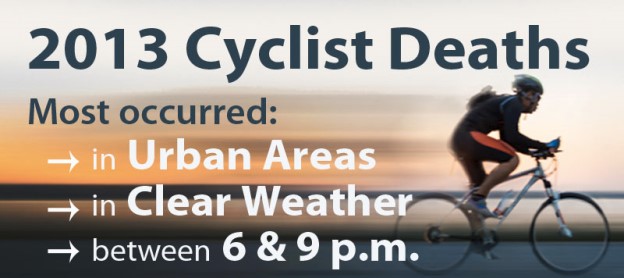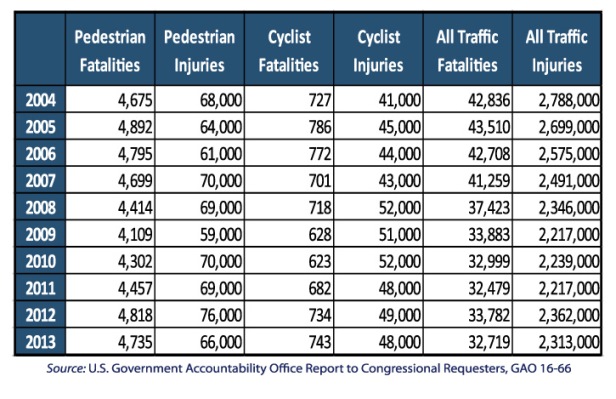Save the MAMILs – Cyclist Injury & Death Statistics
Wrongful Death Attorney
by Thomas Cecil
According to a recent government report, MAMILs (Middle Aged Men In Lycra) are the likeliest of all age groups and genders to be killed or seriously injured while riding a bicycle.
In its report to the US Congress last November (Pedestrian and Cyclist Safety), the General Accounting Office found that of the 743 cyclists who died and the estimated 48,000 who were injured in 2013, 87 percent of those killed were male with an average age of 44, and 83 percent of those injured were male with an average age of 33. Men between 55 and 59 “made up the largest number of cyclist fatalities”.

Although the report didn’t actually reference what the cyclists were wearing, it did confirm that more and more people, in fact over a million more, started riding or walking to work between 2005 and 2013. Riding a bicycle or walking to work clearly is not without risk. As the study points out, fatalities and injuries involving pedestrians and bicyclists remain relatively high while at the same time deaths and injuries from traffic collisions have fallen significantly.
The individual human tragedies are found in the numbers. In 2004, 727 cyclists were killed commuting to work and the annual number of deaths since then “has ranged between 623 and 786”. Cyclist injuries in 2004 were 41,000 and by 2013 were 48,000. Pedestrian deaths and injuries are worse: 4,675 deaths and 68,000 injures in 2004; 4,735 deaths and 66,000 injuries in 2013.
With respect to cyclists, the report notes that most traffic crashes that resulted in death in 2013 “occurred in urban areas, happened in clear weather conditions, and most frequently took place between 6:00 p.m. and 9:00 p.m.” Unlike pedestrian deaths which occurred under similar circumstances, “more cyclists (405) died during daylight rather than in the dark.”
Why are MAMILs and Others in Such Danger?

The study notes many possible factors, including increased walking and cycling trips, alcohol use, distracted driving, cycling and walking due to cell phone use, texting and eating. Another factor is the fact that roadways are built to accommodate cars rather than bicyclists and pedestrians.
As noted, as more and more people bike and walk to work, it is more likely that more cyclists and pedestrians will be involved in crashes. The report indicates, however, that when the numbers of cyclists and walkers in a particular area increase, the number of fatalities and injuries in that area decreases. Reasons given include drivers become used to seeing walkers and riders and change their behavior by driving more slowly. Thus more walkers and cyclists may actually improve safety and decrease deaths and injuries.
As also noted, distracted driving remains a serious threat to cyclists and walkers. In 2013 alone, 3,154 people died in motor vehicle crashes involving distracted driving. According to the report, 480 deaths “were pedestrians, cyclists, or other non-motorists.”
With respect to road design, historically engineers designed roads meant to accommodate motor vehicles with wide straight roads often the goal. Unfortunately, the report notes, wide straight roads lead to faster traffic and speeding. A speeding driver has less time to react and the severity of the crash is much more likely to kill or seriously injure the cyclist or pedestrian.
So, what’s the solution?
Three Es of Safety for Pedestrians & Cyclists
1. Engineering: better use of data to identify problem roadways and concentrations of cyclists and pedestrians; the use of highway design documents specific for cyclists and pedestrians such as the Pedestrian and Bike Guides, Urban Bikeway Design Guide and Designing Walkable Urban Thoroughfares: A Context Sensitive Approach.
2. Education: collaborative education campaigns to educate the public on bike riding and walking safety along with officer training on pedestrian and cyclist safety and traffic laws.
3. Enforcement: targeting areas with a high-frequency of crashes for law enforcement action.
(According to the Federal Highway Administration, there is typically a fourth “E” in highway safety, for “Emergency Medical Services” but it is not mentioned in this report.)
As bicycling and walking in urban areas is likely to only increase, and as more and more people look to biking and walking for exercise and recreation, drivers, city planners and walkers and bike riders will all have to learn to share the road. And remember, #SaveTheMamils.
Thomas Cecil is a Shareholder in our Personal Injury Practice Group.
